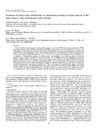Identificador persistente para citar o vincular este elemento:
https://accedacris.ulpgc.es/jspui/handle/10553/51647
| Campo DC | Valor | idioma |
|---|---|---|
| dc.contributor.author | Baltar, Federico | en_US |
| dc.contributor.author | Aristegui, Javier | en_US |
| dc.contributor.author | Gasol, Josep M. | en_US |
| dc.contributor.author | Sintes, Eva | en_US |
| dc.contributor.author | Herndl, Gerhard J. | en_US |
| dc.contributor.other | Aristegui, Javier | - |
| dc.contributor.other | Herndl, Gerhard | - |
| dc.contributor.other | Baltar, Federico | - |
| dc.contributor.other | Sintes, Eva | - |
| dc.contributor.other | Gasol, Josep M | - |
| dc.date.accessioned | 2018-11-25T02:30:03Z | - |
| dc.date.available | 2018-11-25T02:30:03Z | - |
| dc.date.issued | 2009 | en_US |
| dc.identifier.issn | 0024-3590 | en_US |
| dc.identifier.uri | https://accedacris.ulpgc.es/handle/10553/51647 | - |
| dc.description.abstract | The distribution of prokaryotic abundance (PA), respiratory activity (ETS), heterotrophic production (PHP), and suspended particulate (POM) and dissolved (DOM) organic matter was determined in the meso‐ and bathypelagic waters of the (sub)tropical North Atlantic. PA decreased by one order of magnitude from the lower euphotic zone to the bathypelagic waters, while ETS decreased by two and PHP by three orders of magnitude. On a section following the Mid‐Atlantic Ridge from 35ºN to 5ºN, ETS below 1000‐m depth increased southwards up to three‐fold. This latitudinal gradient in the deep waters was paralleled by a six‐fold increase in Particulate Organic Carbon (POC), whereas no trend was apparent in the DOM distribution. Significant correlations between POM and ETS were obtained in the water masses between 1000‐m and 3000‐m depth, the Antarctic Intermediate Water and the North East Atlantic Deep Water. A strong imbalance in the dark ocean was found between prokaryotic carbon demand (estimated through two different approaches) and the carbon sinking flux derived from sediment‐trap records corrected with 230Th. The imbalance was greater when deeper in the water column, suggesting that the suspended carbon pool must account for most of the carbon deficit. Our results, together with other recent findings discussed in this paper, indicate that microbial life in the dark ocean is likely more dependent on slowly sinking or buoyant, laterally advected suspended particles than hitherto assumed. | en_US |
| dc.language | eng | en_US |
| dc.publisher | 0024-3590 | |
| dc.relation.ispartof | Limnology and Oceanography | en_US |
| dc.source | Limnology And Oceanography [ISSN 0024-3590], v. 54 (1), p. 182-193 | en_US |
| dc.subject | 251001 Oceanografía biológica | en_US |
| dc.subject.other | Bacterioplankton Distribution | |
| dc.subject.other | Electron-Transport | |
| dc.subject.other | Oxygen-Consumption | |
| dc.subject.other | Sediment Traps | |
| dc.subject.other | Ocean | |
| dc.subject.other | Respiration | |
| dc.subject.other | Flux | |
| dc.subject.other | Bacteria | |
| dc.subject.other | Eastern | |
| dc.subject.other | Particles | |
| dc.title | Evidence of prokaryotic metabolism on suspended particulate organic matter in the dark waters of the subtropical North Atlantic | en_US |
| dc.type | info:eu-repo/semantics/Article | en_US |
| dc.type | Article | en_US |
| dc.identifier.doi | 10.4319/lo.2009.54.1.0182 | |
| dc.identifier.scopus | 61649112203 | - |
| dc.identifier.isi | 000265168800015 | - |
| dcterms.isPartOf | Limnology And Oceanography | |
| dcterms.source | Limnology And Oceanography[ISSN 0024-3590],v. 54 (1), p. 182-193 | |
| dc.contributor.authorscopusid | 23476314200 | - |
| dc.contributor.authorscopusid | 7006816204 | - |
| dc.contributor.authorscopusid | 7003299234 | - |
| dc.contributor.authorscopusid | 15833225000 | - |
| dc.contributor.authorscopusid | 7005513845 | - |
| dc.description.lastpage | 193 | - |
| dc.description.firstpage | 182 | - |
| dc.relation.volume | 54 | - |
| dc.investigacion | Ciencias | en_US |
| dc.type2 | Artículo | en_US |
| dc.contributor.daisngid | 1232580 | - |
| dc.contributor.daisngid | 227201 | - |
| dc.contributor.daisngid | 97985 | - |
| dc.contributor.daisngid | 935469 | - |
| dc.contributor.daisngid | 99734 | - |
| dc.identifier.investigatorRID | D-5833-2013 | - |
| dc.identifier.investigatorRID | B-1513-2013 | - |
| dc.identifier.investigatorRID | C-3260-2012 | - |
| dc.identifier.investigatorRID | H-8494-2015 | - |
| dc.identifier.investigatorRID | B-1709-2008 | - |
| dc.utils.revision | Sí | en_US |
| dc.contributor.wosstandard | WOS:Baltar, F | |
| dc.contributor.wosstandard | WOS:Aristegui, J | |
| dc.contributor.wosstandard | WOS:Gasol, JM | |
| dc.contributor.wosstandard | WOS:Sintes, E | |
| dc.contributor.wosstandard | WOS:Herndl, GJ | |
| dc.date.coverdate | Enero 2009 | |
| dc.identifier.ulpgc | Sí | es |
| dc.description.jcr | 3,545 | |
| dc.description.jcrq | Q1 | |
| dc.description.scie | SCIE | |
| item.fulltext | Con texto completo | - |
| item.grantfulltext | open | - |
| crisitem.author.dept | GIR IOCAG: Oceanografía Biológica y Algología Aplicada | - |
| crisitem.author.dept | IU de Oceanografía y Cambio Global | - |
| crisitem.author.dept | Departamento de Biología | - |
| crisitem.author.orcid | 0000-0002-7526-7741 | - |
| crisitem.author.parentorg | IU de Oceanografía y Cambio Global | - |
| crisitem.author.fullName | Arístegui Ruiz, Javier | - |
| Colección: | Artículos | |
Citas SCOPUSTM
112
actualizado el 08-jun-2025
Citas de WEB OF SCIENCETM
Citations
106
actualizado el 08-jun-2025
Visitas
126
actualizado el 20-ene-2024
Descargas
303
actualizado el 20-ene-2024
Google ScholarTM
Verifica
Altmetric
Comparte
Exporta metadatos
Los elementos en ULPGC accedaCRIS están protegidos por derechos de autor con todos los derechos reservados, a menos que se indique lo contrario.
